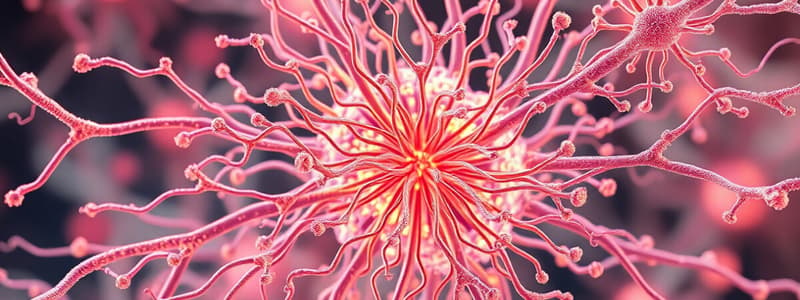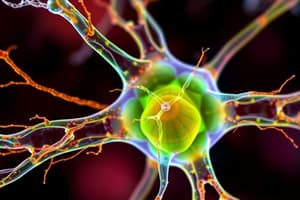Podcast
Questions and Answers
What are the three types of protein filaments in the cytoskeleton?
What are the three types of protein filaments in the cytoskeleton?
- Intermediate filaments, Glycoproteins, Collagen
- Microtubules, Lipid rafts, Actin filaments
- Actin filaments, Myofilaments, Amyloid fibers
- Intermediate filaments, Microtubules, Actin filaments (correct)
What is the structural composition of intermediate filaments?
What is the structural composition of intermediate filaments?
- Rigid rods composed of carbohydrates
- Short protein segments
- Rope-like structures made from twisted strands (correct)
- Flexible chains of nucleic acids
How do protein subunits assemble into intermediate filaments?
How do protein subunits assemble into intermediate filaments?
- Using beta-sheets to form flat sheets
- Through a coiled coil shape of dimers and tetramers (correct)
- By forming monomers that aggregate randomly
- By binding with lipids to create a membrane
What is the primary function of intermediate filaments in cells?
What is the primary function of intermediate filaments in cells?
What term describes the stable dimers formed by protein subunits in intermediate filaments?
What term describes the stable dimers formed by protein subunits in intermediate filaments?
Which of the following is NOT a class of intermediate filaments?
Which of the following is NOT a class of intermediate filaments?
What type of intermediate filaments are found in epithelial cells?
What type of intermediate filaments are found in epithelial cells?
Which type of filaments are known to support nerve cells?
Which type of filaments are known to support nerve cells?
What is the formation process of the rope-like structure of intermediate filaments?
What is the formation process of the rope-like structure of intermediate filaments?
Which of the following statements is true regarding the filament structure?
Which of the following statements is true regarding the filament structure?
What direction do kinesins typically move along microtubules?
What direction do kinesins typically move along microtubules?
What is the main function of dyneins in a cell?
What is the main function of dyneins in a cell?
What structure allows cilia to create movement?
What structure allows cilia to create movement?
The 9 + 2 arrangement of microtubules is characteristic of which structures?
The 9 + 2 arrangement of microtubules is characteristic of which structures?
What role do actin binding proteins play in cell function?
What role do actin binding proteins play in cell function?
What is the process called where actin monomers move through the filament from plus end to minus end?
What is the process called where actin monomers move through the filament from plus end to minus end?
What facilitates the bending motion of cilia and flagella?
What facilitates the bending motion of cilia and flagella?
How do motor proteins determine the type of cargo they can transport?
How do motor proteins determine the type of cargo they can transport?
What type of motion does a cilium perform during its cycle?
What type of motion does a cilium perform during its cycle?
What is formed by actin filaments in human blood cells to support their shape?
What is formed by actin filaments in human blood cells to support their shape?
What happens to the nuclear lamina during cell division?
What happens to the nuclear lamina during cell division?
What process is responsible for the disassembly and reassembly of the nuclear lamina?
What process is responsible for the disassembly and reassembly of the nuclear lamina?
What are tubulin dimers primarily composed of?
What are tubulin dimers primarily composed of?
What is the structural polarity of protofilaments in microtubules?
What is the structural polarity of protofilaments in microtubules?
During dynamic instability, what happens to microtubules?
During dynamic instability, what happens to microtubules?
How does GTP hydrolysis affect microtubule stability?
How does GTP hydrolysis affect microtubule stability?
What anchors the minus end of microtubules in animal cells?
What anchors the minus end of microtubules in animal cells?
What can stabilize a growing microtubule?
What can stabilize a growing microtubule?
Which of the following is NOT a characteristic of polarized animal cells?
Which of the following is NOT a characteristic of polarized animal cells?
What is the primary function of motor proteins along microtubules?
What is the primary function of motor proteins along microtubules?
What initiates the process of muscle contraction in skeletal muscles?
What initiates the process of muscle contraction in skeletal muscles?
What role do Ca2+ ions play in muscle contraction?
What role do Ca2+ ions play in muscle contraction?
How does myosin II facilitate muscle contraction?
How does myosin II facilitate muscle contraction?
What structure anchors the plus ends of actin filaments in a sarcomere?
What structure anchors the plus ends of actin filaments in a sarcomere?
What is the primary function of actin-binding proteins in muscle cells?
What is the primary function of actin-binding proteins in muscle cells?
What occurs when a muscle cell receives an electrical signal from a nerve?
What occurs when a muscle cell receives an electrical signal from a nerve?
What is the composition of a sarcomere?
What is the composition of a sarcomere?
What happens to Ca2+ levels after the stimulation of a skeletal muscle by a motor nerve ends?
What happens to Ca2+ levels after the stimulation of a skeletal muscle by a motor nerve ends?
What structural characteristic gives vertebrate myofibrils a striped appearance?
What structural characteristic gives vertebrate myofibrils a striped appearance?
In smooth muscle, what must occur before contraction can be triggered?
In smooth muscle, what must occur before contraction can be triggered?
Flashcards are hidden until you start studying
Study Notes
Cytoskeleton Overview
- Composed of three protein filament types: intermediate filaments, microtubules, and actin filaments.
- Each filament has distinct mechanical properties and is constructed from different proteins.
- Present in epithelial cells and almost all animal cells.
Intermediate Filaments
- Strong, rope-like structures providing tensile strength through twisted strands.
- Composed of protein subunits featuring a central rod domain with unstructured ends.
- Rod domains contain a helical structure, allowing proteins to form stable dimers via coiled-coil formations.
- Dimers associate to form staggered tetramers, which align side by side to create the filament structure.
Classes of Intermediate Filaments
- Four classes exist:
- Keratin filaments in epithelial cells.
- Vimentin and related filaments in connective tissue, muscle, and glial cells.
- Neurofilaments in nerve cells.
- Nuclear lamins in the nuclear envelope.
- Cytoplasmic types include keratin, vimentin, and neurofilaments; nuclear lamins are restricted to the nucleus.
Nuclear Lamina Dynamics
- Composed of lamins that disassemble during cell division, reforming afterward.
- Controlled by the phosphorylation and dephosphorylation of lamins, affecting stability.
- Phosphorylation alters lamin shape, weakening bonds leading to filament disassembly; dephosphorylation allows for reassembly.
Microtubule Structure
- Formed from tubulin dimers, consisting of alpha and beta tubulin.
- Dimeric structure tightly bound by noncovalent interactions to create the microtubule's wall.
- Composed of 13 protofilaments, each exhibiting polarity (plus end at beta tubulin, minus end at alpha tubulin).
Centrosome Function
- The organizing center for microtubules, containing centrioles and a protein matrix composed of gamma tubulin rings.
- Microtubules grow from gamma tubulin rings, with alpha and beta tubulin dimers adding to the plus end.
Dynamic Instability of Microtubules
- Microtubules exhibit dynamic instability, alternating between phases of growth and rapid shrinkage.
- Stabilization occurs when the plus end interacts with cellular structures, preventing depolymerization.
- Growth rate is influenced by GTP hydrolysis in tubulin dimers; GTP-bound dimers promote stability, while GDP-bound ones contribute to instability.
Cell Polarization
- Most animal cells are polarized with distinct structural and functional differences at each end.
- In neurons, axons and dendrites show directed microtubule polarity aiding in transport.
Motor Proteins
- Kinesins and dyneins are motor proteins that navigate microtubules; kinesins move toward the plus end while dyneins move toward the minus end.
- Each motor protein possesses a tail for cargo binding and ATP binding heads for directional movement.
Cilia and Flagella Motility
- Cilia perform whip-like motions to transport fluids or propel cells; beat cycles consist of power and recovery strokes.
- Flagella, longer than cilia, propel entire cells, such as sperm, through fluid.
- Both structures feature a unique 9+2 arrangement of microtubules.
Microtubule Bending Mechanism
- Force generated by dynein molecules enables bending, as they interact with neighboring microtubules.
- Flexible linkages between microtubules transform sliding forces into bending movement.
Actin Filaments
- Interact with actin-binding proteins, forming stable structures such as microvilli or creating temporary structures for cell movement.
- Myosin motor proteins facilitate actin-based movements.
Actin Dynamics
- Actin filaments are inherently unstable; treadmilling occurs when monomer addition exceeds hydrolysis, causing filament movement.
- Hydrolysis of bound nucleoside triphosphates regulates filament length, similar to microtubule dynamics.
Structural Support in Blood Cells
- Human blood cells contain a network of fibrous proteins like actin and spectrin, providing structural support to maintain their disc-like shape.
Cell Crawling Mechanisms
- Involves coordinated changes across different cell regions, relying on three key processes essential for effective cell movement.### Cell Movement
- Protrusions at the leading edge allow cell crawling by anchoring to surfaces.
- Actin polymerization drives forward movement through the plasma membrane, establishing new actin cortex regions.
- Old anchorage points detach, enabling a repetitive stepwise movement.
Actin and Myosin Dynamics
- Actin-binding proteins facilitate filament growth at leading edges and disassembly at the rear.
- Myosin I interacts with actin filaments, utilizing ATP for movement and vesicle transport along the filaments.
- Head domains of myosin I always progress towards the plus ends of actin filaments.
Myosin II Structure
- Muscle myosin belongs to the myosin II subfamily, consisting of dimers with two ATPase heads and coiled-coil tails.
- Clustering forms bipolar filaments that enable sliding actions on actin filaments.
Sarcomeres and Muscle Fibers
- Skeletal muscle fibers are multinucleated, formed by smaller cell fusion, with most cytoplasm composed of myofibrils.
- Myofibrils consist of repeating structural units (sarcomeres) approximately 2.5 µm in length, giving muscles their striped appearance.
Sarcomeres Composition
- Actin (thin) and myosin (thick) filaments make up sarcomeres, with actin anchored to Z discs.
- Myosin filaments are centrally located, with actin filaments extending from each end.
Muscle Contraction Mechanism
- Muscle contraction results from synchronized shortening of sarcomeres through the sliding of actin past myosin without filament length alteration.
- Myosin heads engage with actin via a cycle of attachment, movement, and detachment triggered by nerve signals.
Role of Calcium Ions (Ca2+)
- Muscle contraction is initiated when motor nerve signals promote the release of Ca2+ from the sarcoplasmic reticulum into the cytosol.
- Ca2+ levels rise trigger further interactions between actin and myosin by relieving the inhibitory effect of tropomyosin.
Troponin and Tropomyosin Interaction
- Tropomyosin and troponin regulate myosin binding to actin; tropomyosin prevents binding until Ca2+ alters troponin configuration.
- Increased cytosolic Ca2+ causes these protein movements, facilitating muscle contraction initiation.
Signal Propagation and Reversal
- The electrical signal from the plasma membrane reaches all sarcomeres rapidly, leading to simultaneous contraction of myofibrils.
- Elevated Ca2+ levels are transient; pumps in the sarcoplasmic reticulum restore normal levels swiftly, halting muscle contraction.
Smooth Muscle Function
- Smooth muscle, found in various organs, contracts involuntarily and more slowly than skeletal muscle.
- Activation mechanisms involve enzyme-mediated phosphorylation and dephosphorylation of myosin heads, responsive to multiple signaling molecules.
Studying That Suits You
Use AI to generate personalized quizzes and flashcards to suit your learning preferences.




